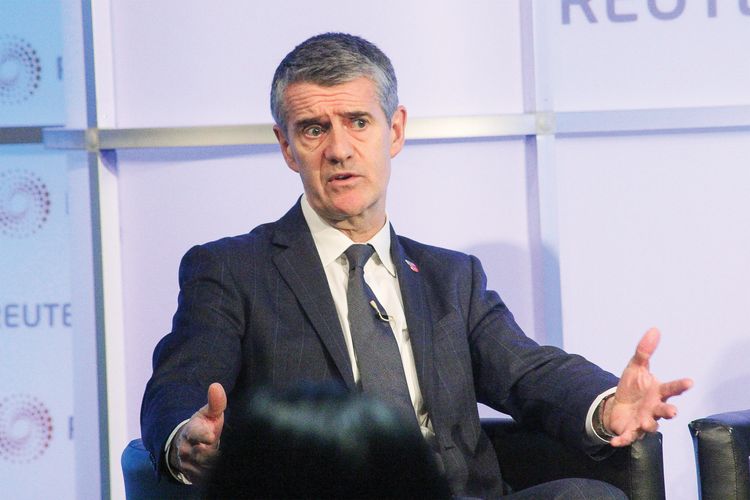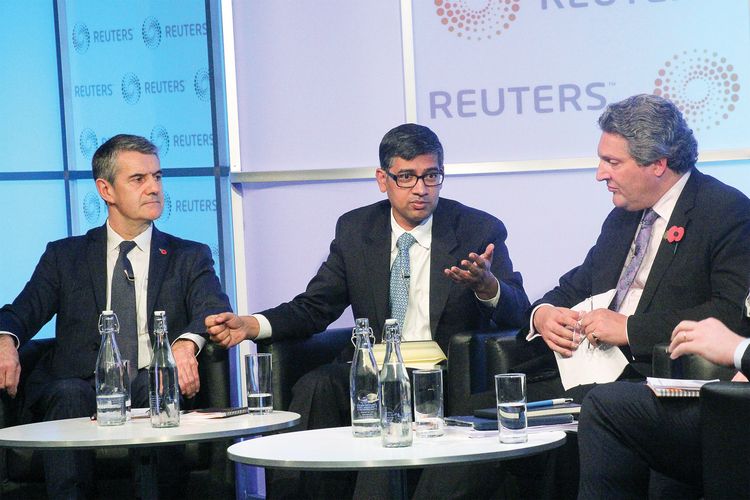IFR: Welcome to this IFR Roundtable on the Outlook for International Debt Capital Markets. Our discussion today is centred on what’s at play in the international bond market, from the perspective of both primary and secondary markets and how the tone of the market might be shifting with potential policy divergence between the ECB, Fed, and BoJ.
We’ve seen a lot of volatility since the end of the summer, Is the market is at a pivot point where it ceases to be a sellers’ market and moves into a different part of the cycle? And what difference will a Fed rate rise make? Will it give rise to thunderous volatility, as some people think?
How will the policy underpinnings impact the primary market? On a year-on-year basis, we’ve seen a decline of around 15% in global debt issuance, while in high yield, there’s been a halving in the number of issues and a more than a quarter in the volume of issuance.
On the international side, which will be the focus of our discussion today, we have seen similarly a 10%-11% decline in issuance, and close to a 20% decline in the number of issues. What conclusions should we draw from that?
I also want to focus on 2016 and how the market deals with the headwinds that are out there, including EM and commodity prices, and how we factor in idiosyncratic risk. All in all, we’ve got a lot of moving parts.
Morven, the general feeling seems to be that the tone of the international bond market has taken a turn for the worse. We’ve had new issues that have struggled to get over the finish line, while levels of oversubscription are not as ebullient as they were. Is the market moving into defensive mode?
Morven Jones, Nomura: If you look at the market conditions this calendar year compared with last year, there’s no question we’ve seen quite a significant change in sentiment. It was true that from the crisis onwards, the bond market was a much easier place for new issuance than everybody had imagined. It was relatively easy to issue debt with little or no issue premium. And we saw those multiple subscriptions. Timing was not that important.
This year, we’ve seen the market becoming more challenging. Timing has been more important, there has been more volatility and investors have certainly been more demanding when it comes to pricing. And that’s without question meant a new-issue premium of some kind. Subscription levels have been far lower, with issues just creeping over the line in many cases or in some cases, issues not being fully subscribed. The market has become more difficult.
One of the questions is whether this is something that is bad and a worry or whether it’s normalisation, because I would say that the conditions we had post-crisis were the abnormality rather the normality.
At a high level, we had an OK beginning to the year; we had a very challenging middle of the year, certainly from a new-issue perspective; but through October sentiment improved and we saw levels of subscription going up. New-issue premiums are still there but investors are less demanding than they were so hopefully that sentiment will continue.
IFR: Soren, we have seen bouts of volatility but we haven’t seen sustained periods of volatility; we’ve had volatility followed by periods of calm with renewed inflows and improved sentiment. One of the things that makes people nervous is volatility of volatility and what that is telling us. How would you characterise the market?
Soren Willemann, Barclays: Vol of vol is a wonderful academic concept. This year was marked by a fairly strong period in the year, followed by concerns about Greece then stability into the summer followed by concerns about China. The way we think about how primary markets – and it shows up in the data – shows very seasonal patterns. We ran a study recently trying to understand what the deviations are from the seasonal patterns over time. It’s very clear. A 1% change in the VIX index in a given month moves US$5bn of issuance from one month to the other.
People are very concerned about buying bonds in volatile markets, particularly in Europe. Is that good thing? Sure it is. To Morven’s point, talking about investors being more discriminating about what they buy and have oversubscribed books, from a technical position if we see primary issuance flying off the shelf with multiple levels of oversubscription, we tend to see that as a sign of diverging spreads in the near term.
If investors are not discriminating enough, we know that the first time we see a blip in the market, there will be sellers out there; there are people who bought bonds that they necessarily don’t want to own and there are loose ends as a consequence. For marketability, we see it as a very good sign that people are becoming more discriminating.
IFR: From a buy side perspective, Ashish when we get these periods of volatility are you getting better value?
Ashish Dafria, Aviva Investors: In a relative sense, yes. Any bond wider than it was before is clearly a better value for us. But I think one of the questions that we ask is: yes we have seen some divergence of issuance and issuer behaviour.
But we’ve had bouts of volatility in years past so the question we ask is: where are we going from here? And is the value real? It feels like there are lots of pockets of relative value in the markets but are there good absolute values? Is it a good price to buy from an absolute sense? That’s a harder question to answer.
One of the things that has led to this abnormal period, as Morven described it, is global liquidity, and global central bank policies. If that is beginning to change and depending on where Fed goes, it’s somewhat natural in our mind that it will have some consequences on issuer behaviour and on market conditions. Sitting where we are, can we really see a sustained change? That’s the bigger question in my mind.
IFR: How do you see the impact of central bank policy divergence? If the Fed hikes, do we ultimately get Fed hike to the power of two if the ECB continues easing? What does that do to market value or perceptions of value? How should the market look at policy rates and how they play into the market for new issuance?
Ashish Dafria, Aviva Investors: Thinking about it from a corporate perspective and on levels on corporate issuance the impact is probably twofold. We have all been a little guilty of over-thinking the Fed’s next move and what exactly the body language is but it’s a bit of a red herring in my mind. Yes the Fed will hike eventually but is it the start of a hiking cycle? Is it one or two hikes or a longer series? That’s the real question.
From a global central bank liquidity perspective, we see conditions remaining favourable. The Fed is not going to hike a lot; the ECB, as you said, is expected to ease; Japan and China somewhat similar. From a macro liquidity perspective, the conditions may not be a straight line but the overall environment still looks to be benign; full of liquidity with relatively limited investment options.
But where we are heading from a credit-cycle perspective is clearly dependent on where the interest-rate cycle ends up. And differences emerge as we look at different markets and different geographies. The US is clearly showing late-cycle behaviour. US leverage metrics are deteriorating; the corporate metrics are OK but they are beginning to come down. Europe is much further behind.
So it’s not just monetary policy. From a fundamental credit-cycle perspective. Europe is lagging and that should continue to present a similar environment to the one we’ve had.
IFR: Fred, what do you take from those comments in terms of how you think issuers are or should be positioning? The immediate knee-jerk reaction for issuers is to try and front-run a tightening cycle and there may not be not much time left to do that.
[During October] we did see a lot of emerging market issuers in the bond market and to Morven’s point, sentiment has picked up. I sense conflicting signals at the policy level and in [US and European] credit markets. Morven referenced the reduction in over-subscription levels and some issuers finding it difficult to get it over the line. Where does your mind sit in all of this?
Fred Zorzi, BNP Paribas: It’s a big question. Let’s take a step back. Where are we today? Today [the discussion took place on November 1], the market is very strong but we need to look at the difference between short-term (year-end) and longer term.
Short-term, there has been a lot of negative news but investors were expecting it. We’ve seen some very strong de-risking over the past few weeks if not months. We saw a couple of bad numbers in October but the market didn’t react poorly. That was it a sign that de-risking had gone too far since the news wasn’t that bad. What we saw [in October] was investors catching up.
Then we need to look forward. Europe and the US are in very different cycles so looking at real yields is crucial. In Europe, they’re expected to go down while in the US we expect them to go up so we should see further divergence.
On the EM question you brought up, yes we have seen a lot of EM issuance but mainly sovereigns and I think it’s been a smart way to re-enter a market that has been a bit over-sold. The main beneficiary of QE in the US has been the EM world but mainly corporates; sovereigns have come in on the back of that.
Local currencies may suffer and sovereigns might be limited in their ability to cut rates but for most of those countries, the overall situation is not that bad and looks sustainable. We saw that with the likes of Angola and Peru; feedback was positive. Investors want to play EM sovereigns although for me, that doesn’t really represent the market.
More generally, in terms of issuers, to go back to that, at this stage I don’t think there’s a sense of urgency. We all know that issuers tend to react a lot more slowly but their funding has been done for the year, although they can engage in pre-funding.
What will be interesting is whether we see any acceleration. Is it likely to be so big that it will put pressure on spreads? No. I don’t think supply [patterns] up until Christmas will change. Are issuers worried at this stage? Not really.
Soren Willemann, Barclays: I just want to make a point on the EM side. It’s something we look a lot at because it’s very much human nature that when you think about drivers of volatility in developed-world credit, you sometimes need to look outside your market. One thing our investors look at a lot is the potential for EM volatility to flow into our markets. One thing people definitely point to is the fact that EM has issued a lot.
There are studies done by the IMF showing a clear link between the Fed QE and issuance in EM. Back in 2013 when we had the taper tantrum and Bernanke talking about rate hikes, we saw a lot of volatility in EM; part of that volatility was retail funds selling out to institutionals.
We think at an overall level, the investor base in EM is much steadier these days. It’s institutional money and it’s probably not going anywhere any time soon. We don’t see any concerns around this boom in EM volatility.
To see the digital version of this roundtable, please click here
To purchase printed copies or a PDF of this report, please email gloria.balbastro@thomsonreuters.com

